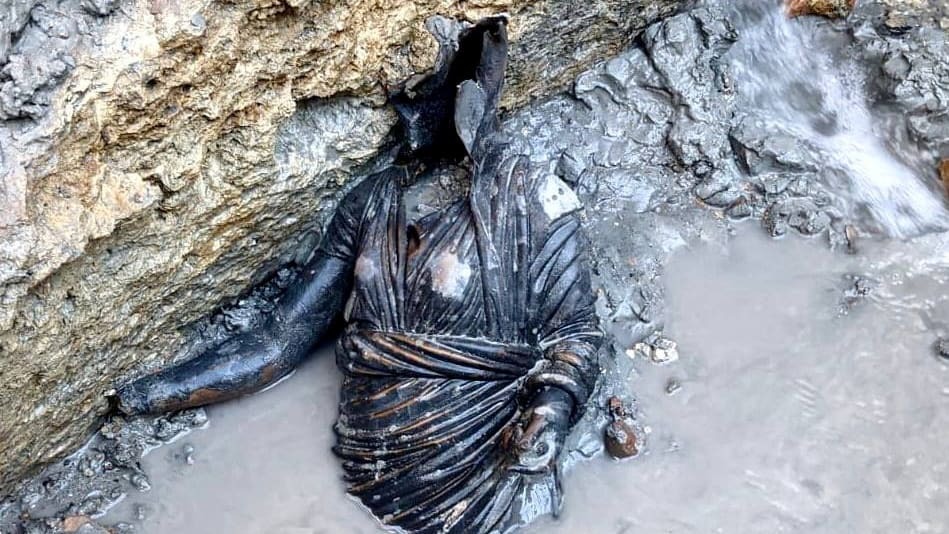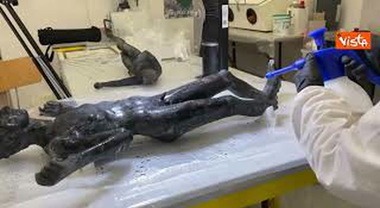It’s like discovering oil Tuscan town celebrates spa trove find

San Casciano dei Bagni anticipates a shift in fortune following the discovery of a lavish Etruscan-Roman sanctuary.
Martina Canuti, since childhood, has descended the steep hill next to San Casciano dei Bagni in Tuscany, known as “the sacred mountain,” to indulge in the therapeutic hot springs. Unbeknownst to her, just a few meters away, an Etruscan sanctuary from the second century BC held a trove of treasures that could potentially transform the fortunes of this secluded town of 1,400 residents near Siena.
A recent archaeological project, spearheaded by Mayor Agnese Carletti with support from government and private funding, led to the discovery of 24 bronze statues, primarily dedicated to the gods. These artifacts were found buried by mud and boiling water in the remains of a network of thermal springs that had served as a place of worship for both the Etruscans and Romans.
Reflecting on the discovery, Carletti expressed optimism, stating, “It’s as if we found oil. Maybe all these gods are now bringing us some good fortune.” She hopes that the newfound treasures will attract tourism, providing an economic boost to a town grappling with challenges due to depopulation.
The bronzes, marking the most significant discovery of their kind in Italy, featured various statues, such as a sleeping ephebe positioned alongside Hygeia, the goddess of health, adorned with a snake wrapped around her arm. Another statue was dedicated to Apollo, the god of sun and light.
These sculptures, believed to have been commissioned by affluent local families, were originally displayed along the edge of the oval-shaped baths. They were later immersed into the water during a ceremonial event thought to have taken place in the first century AD.
Archaeological digs have additionally revealed 6,000 coins and various votive offerings. These votives consist of small figurines portraying a hand holding money, a penis, a pair of breasts, and an infant wrapped in swaddling clothes. These items were likely presented as offerings to the gods, accompanied by holy water, with the intention of seeking fertility or overall good fortune.
Heading the project, which locals have fondly compared to something that could be led by Indiana Jones, is Dr. Jacopo Tabolli, an assistant professor at the University for Foreigners in Siena.
Dr. Jacopo Tabolli explained that the sanctuary, initially established during the Etruscan era and later enhanced in opulence during the Roman period, saw continued use until the 5th century AD. Eventually, it was closed but not demolished during the Christian era. Stone pillars were employed to seal the pools, while the divine statues were left within the water, rich in minerals such as calcium and magnesium.
The therapeutic properties of the water were esteemed for liver health, alleviating facial pain, and aiding fertility. The site was associated with ritualistic practices related to pregnancy, emphasizing the significance of natality. However, the water itself was not potable, being toxic.
Inscriptions in both Etruscan and Roman scripts have been uncovered at the location. Tabolli highlighted that the artifacts discovered thus far serve as a significant testament to the transition between these historical periods, with the baths being regarded as a tranquil sanctuary.
The advent of the Christian era marked the end of the sanctuary’s use for pagan rituals. However, the hot springs adjacent to the sanctuary, along with others scattered across the Tuscan landscape, drew visitors from across Europe during the Renaissance.
In 1585, the Medicis constructed a structure at the site, unearthing relics, including altars, during excavations. These discoveries were subsequently transported to the nearby Roman baths of Fontaverde, where the Medicis erected a palace. Fontaverde has long held the limelight in terms of hot springs, but the recent revelations in San Casciano dei Bagni are generating excitement in the town.
The retrieved relics will undergo restoration, followed by in-depth studies in the coming months. Eventually, they will find a home in a museum set up in a 16th-century building recently acquired by the Italian Ministry of Culture. Anticipated future excavations at the site, slated to become an archaeological park, may reveal additional treasures.

While bathing in the thermal springs under the light of a full moon, Sabrina Lepri, a visitor from Perugia, expressed surprise at the existence of the adjacent cordoned-off archaeological site. Lepri, who has been visiting for 25 years, cherishes the springs for their natural charm and hopes that newfound fame won’t alter the experience too much.


